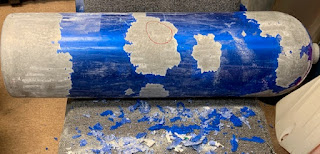Healthy Regulators - The heart of your scuba unit
 |
| Photo: Fred Stratton |
By Fred Stratton
Bubbles or Not Diving
Instructor & Repair Technician
Your regulators are the heart of your scuba life support system. Like the body’s heart, your regulators will be there for you…if you take care of them. Keeping your scuba gear diveworthy involves periodic maintenance. Properly maintaining one’s vehicle is required to fulfill the owner’s warranty responsibility. Scuba manufacterers have the same requirement and the work must be performed by a trained, authorized technician.
If your annual (or biannual) service is due in February but you plan to dive that month, set a reminder in your phone to get them serviced in January. This will keep your product in warranty and preclude having to rent gear at your dive destination. Other factors to consider are the manufacturer’s service requirements, number of dives since the last servicing, and your diving environment (salt water, fresh water, or contaminated water in the case of commercial or recovery divers).
If you dive mainly in fresh water (e.g. caves, lakes, quarries) don’t be tempted to extend time between servicing because your “gear gets a fresh water rinse” every time you dive. High pressure seats, O-rings and diaphragms are slowly wearing out with each breath you take.
Some manufacturers, like Scubapro, offer parts for life as long as the regulator is serviced every 24 months or 100 dives by an authorized technician. The diver only pays for labor. (Try getting this deal from your auto mechanic!)
The insidious nature of corrosion
Corrosion is from the Latin word corros meaning gnawing away. All metals corrode including platinum and gold (although their corrosion products decompose spontaneously into pure metal). Some metals such as aluminim and stainless steel benefit from passivation, the formation of an ultrathin film on the metal’s surface which limits further corrosion.
 |
| Photo: Fred Stratton |
Most first stage regulators are made from marine (naval) brass, an alloy comprised of 60% copper, 1% tin and 39% zinc. Its strength and corrosion resistance make it ideal for salt and fresh water applications, such as boat propellors and scuba regulators. Plating regulators in chromium provides additional corrosion resistance. This photo shows the effect of salt being allowed to dry, expand, and flake off a large section of the chrome plating. This regulator proved unserviceable due to internal corrosion and pitting. Neglect rendered this high-performance regulator into scrap metal.
The Statute of Liberty is resplendant in her rich green patina, the result of her copper sheathing chemically reacting to the atmosphere. A green regulator is an obvious sign of poor maintenance. The zinc can also corrode (dezincification), compromising the regulator’s strength.
What does the technician do to my regulators?
Complete Disassembly: Takes apart and separates the replaceable parts from the parts that usually last for many years (springs, body, yoke, saddle, balance chamber). The technician can retain the used parts to show the customer what was replaced.
 |
| Photo: Fred Stratton |
Ultrasonic Cleaning: Vibrates a cleaning solution at 35,000 hertz per second to strip away contaminants (salt, silt) and corrosion from each part.
Visual Inspection: Uses a magnifying lamp to inspect visually all critical parts such as the orifice. This orifice's sharp edge must be kept pristine in order to maintain a seal against the high pressure seat, stopping the flow of gas when the diver isn't inhaling.
 |
| Photo: Fred Stratton |
Replace Parts: All regulators have parts that wear and require periodic replacement. As an example, a Dive Rite XT-1 first stage gets 19 new parts including the high pressure seat, static (sealing stationary parts) and dynamic (sealing moving parts) O-rings, the diaphragm, and filter.
Regulators used in oxygen applications (Nitrox, technical diving) require O2-compatible parts such as Viton O-rings and lubricants (e.g. Christo-Lube MCG 111, Tribolube).
 |
| Photo: Scuba Tools |
Set the Intermediate Pressure: Adjusts the first stage to its proper intermediate pressure (IP) to manufacturer’s specifications using sophisticated testing equipment.
Adjust 2nd Stage Regulators: Adjusts each regulator’s work of breathing(WoB) to factory specifications. The WoB is the energy required to inhale and exhale a breathing gas.
Final Check: The technician breathes from each regulator, sprays or immerses the regulators in water to check for leaks, performs a final cleaning and then documents the service in the customer’s profile.
Return to the Customer: Breathe from your newly serviced regulators when you pick them up. This will build trust between you and your local dive shop and give you confidence that they will perform in the water.



Another good article Fred. If I had a big dive trip coming up, unless my reg had just been serviced, I would have it done again. Doesn't hurt and don't want to ruin a trip. Save A Dive kit and fresh service.!
ReplyDelete